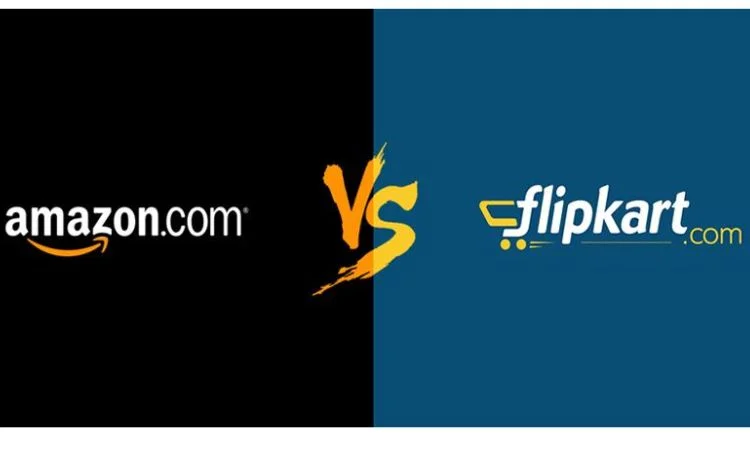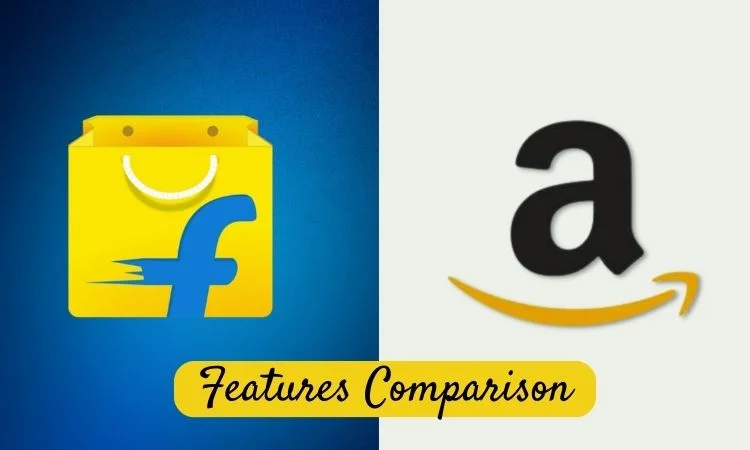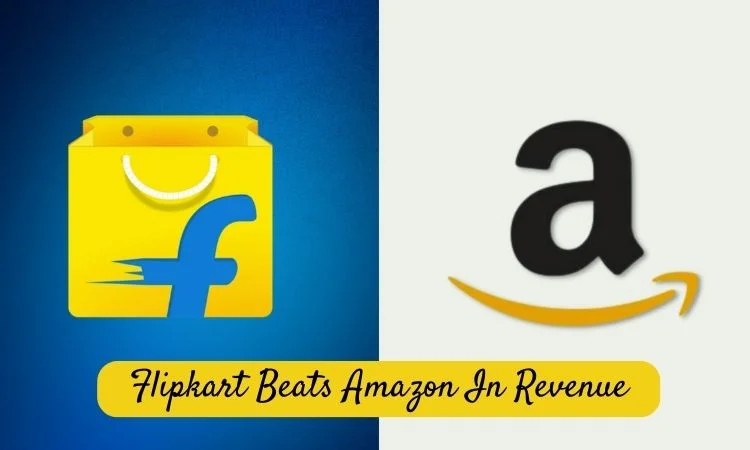On the eve preceding the highly anticipated Big Billion Day sale at Flipkart’s Bengaluru headquarters, a vibrant and spirited atmosphere engulfed the premises.
Amidst the pulsating disco lights and the rhythmic beats of Bollywood music, the company, under the ownership of Walmart, orchestrated a celebratory ambiance to energize its workforce.
In this article, you will learn about Amazon vs Flipkart: Who Is Currently At The Top?

From lively costume parties to invigorating Zumba classes, every conceivable effort was made to uplift the morale of employees, ensuring they remained resilient in the face of the impending sales pressure.
This was no ordinary sales event; it marked the initiation of a monumental showdown between two e-commerce giants, Walmart‘s Flipkart and Amazon, on the Indian retail battlefield.
While for the corporate titans, it was a strategic war for market dominance, for consumers, it presented a unique and advantageous scenario.
The clash between Flipkart’s Big Billion Days and Amazon’s Great Indian Sale has become a subject of analysis, symbolizing the fierce competition between two industry leaders striving for supremacy.
This exemplifies a compelling instance of corporate giants engaging in a strategic battle for a competitive edge, ultimately shaping the landscape of the e-commerce industry in India.
| Parameters | Flipkart | Amazon |
| Founder | Sachin Bansal and Binny Bansal | Jeff Bezos |
| Year | 2007 | 1994 |
| Headquarters | Karnatka , Bangalore, INDIA | Seattle,Washington , USA |
| Exclusivity | Only In India | All over The World. |
On the eve preceding the highly anticipated Big Billion Day sale at Flipkart’s Bengaluru headquarters, a vibrant and spirited atmosphere engulfed the premises.
Amidst the pulsating disco lights and the rhythmic beats of Bollywood music, the company, under the ownership of Walmart, orchestrated a celebratory ambiance to energize its workforce.
Employee Upliftment
From lively costume parties to invigorating Zumba classes, every conceivable effort was made to uplift the morale of employees, ensuring they remained resilient in the face of the impending sales pressure.
Check: Solar Companies In India
This was no ordinary sales event; it marked the initiation of a monumental showdown between two e-commerce giants, Walmart’s Flipkart and Amazon, on the Indian retail battlefield.
While for the corporate titans, it was a strategic war for market dominance, for consumers, it presented a unique and advantageous scenario.
Battlefield Analysis
The clash between Flipkart‘s Big Billion Days and Amazon’s Great Indian Sale has become a subject of analysis, symbolizing the fierce competition between two industry leaders striving for supremacy.
This exemplifies a compelling instance of corporate giants engaging in a strategic battle for a competitive edge, ultimately shaping the landscape of the e-commerce industry in India.
Features Comparison: Amazon vs Flipkart

Product Assortment:
Both e-commerce platforms boast an extensive and diverse product catalog, with Flipkart holding a slight edge owing to its established longevity.
Encompassing a wide array of categories such as electronics, computers, apparel, sports, health, cosmetics, books, and tools, both Amazon and Flipkart offer users a comprehensive selection.
This inclusivity allows users to choose from a rich assortment of options, making the product collections of Amazon and Flipkart highly competitive.
User Interface:
The user interfaces of both platforms exhibit a similar front-end design, yet Flipkart’s interface stands out for its streamlined and user-friendly approach during the ordering, checkout, and payment processes.
Conversely, Amazon distinguishes itself with a clear, practical, and efficient interface that eschews unnecessary features, resulting in a faster and lighter site.
Amazon’s clutter-free graphical user interface enhances the overall customer experience, allowing for a more concise presentation of search results on a single page, a feature not mirrored by Flipkart.
Unique Selling Proposition (USP): Amazon vs Flipkart
Amazon
Amazon Prime and its benefits
For an annual fee of approximately ₹1499 in India, Prime members get exclusive access to entertainment on Prime Video and Prime Music You can access it.
But the benefits aren’t just limited to streaming. Free and fast shipping options allow members to receive their orders in record time, making it extremely convenient.
Wide range of payment options
Amazon’s payments ecosystem is as diverse as India itself. Whether you’re a credit card fraudster or a UPI fanatic, you don’t have to worry.
The platform supports multi-bank credit/debit cards, UPI, mobile wallets, and even cash on delivery (COD).
For those who want to stagger their payments, Amazon offers EMI options and the unique Amazon Pay Later service that makes big-ticket purchases more manageable.
International Brand Presence
Amazon’s global presence is a huge advantage, especially for those looking for international products. The credibility that comes with Amazon’s international reputation is unmatched.
Flipkart
Flipkart Plus and its features
Flipkart Plus is the answer to Amazon Prime. The loyalty program offers free and fast shipping but also has a unique feature of “Plus Coins” that can be collected and redeemed for additional perks. Flipkart Plus gives early access to special offers and promotions, ensuring loyal customers always get the first choice.
A dedicated subsidiary fulfillment service is known as Ekart
When it comes to logistics, Flipkart has a trump card in the form of its in-house fulfillment service, Ekart Logistics. Ekart ensures efficient and fast delivery even to the remotest parts of India.
Homemade Advantage
Flipkart’s roots in the Indian market give it a unique homegrown advantage. The company has a deep understanding of local consumer behavior, which is reflected in customized marketing and sales strategies.
Read: Million Story Behind Red Bulls
Delivery and Shipping Overview:
Both Amazon and Flipkart employ dedicated courier services to facilitate the efficient delivery of goods to their customers.
Flipkart relies on Ekart as its primary delivery service, while Amazon entrusts Amazon Transportation Services (ATS) for its logistics needs.
It is noteworthy that the courier services employed by these prominent e-commerce platforms share remarkable similarities in terms of both quality and reliability. The commitment to providing a seamless and dependable delivery experience is evident in the choice of these reputable courier services by both Amazon and Flipkart.
Customer Service:
In the realm of providing exemplary customer service, Amazon distinguishes itself as a frontrunner when compared to Flipkart.
At Amazon, our dedicated customer care representatives prioritize prompt responsiveness to your inquiries, diligently working to swiftly address and resolve any concerns you may encounter.
In contrast, Flipkart has encountered customer feedback expressing dissatisfaction with their customer support representatives, who, regrettably, are perceived to occasionally fall short in their commitment to resolving customer issues promptly and effectively.
We understand the critical importance of responsive and effective customer service, and Amazon remains committed to consistently exceeding your expectations in this regard.
Payment Methods:
Amazon and Flipkart provide a diverse array of payment options, catering to the varied preferences of their customers. Accepted payment methods on both platforms include Internet Banking, Gift Cards, Cash on Delivery, and Wallet.
Additionally, users can seamlessly make transactions using major credit/debit cards such as Visa, MasterCard, Maestro, and American Express.
For added convenience, Flipkart introduces an innovative credit borrowing solution known as Flipkart Pay Later. This service allows eligible customers to access credit and proceed with their purchases without the immediate need for payment information.
Amazon offers a comparable feature called Amazon Pay EMI, providing users with an accessible credit option specifically tailored for online shopping.
Value Added Services:
In the realm of value-added services, Amazon stands out by offering a unique gift packaging service for select products. Termed as “Gifts,” Amazon will professionally package the chosen items and include a personalized gift note, enhancing the overall shopping experience.
It’s important to note that this particular feature is not currently available on Flipkart.
The subscription model has gained significant traction with the rise of online services, and both Flipkart and Amazon have capitalized on this trend. Customers can now subscribe to premium services such as Amazon Prime and Flipkart Plus, each requiring an annual fee.
These subscriptions unlock a host of additional services and benefits, providing users with an enhanced and exclusive online shopping experience.
Regulatory hurdles faced by the brands
Navigating regulatory challenges is a critical aspect for brands operating in dynamic market landscapes. In this context, Flipkart leverages its advantageous position as a domestic entity, affording it a comparative advantage with fewer legal constraints.
Conversely, Amazon, despite its commendable performance since its 2013 inception, faced a delayed entry into the market and encountered a series of regulatory obstacles.
In response to the government’s recent announcement regarding direct investment, Amazon is diligently addressing these regulatory challenges, aiming to align itself with domestic competitors.
This strategic approach has played a pivotal role in fostering the company’s success, particularly in meeting the evolving preferences of the Indian consumer base through a focus on personalized offerings.
Don’t Miss: Inspiring Story Of Henry Nestle
A Strategic Analysis of Amazon and Flipkart’s Ongoing Struggle
In the dynamic realm of e-commerce, a compelling narrative unfolds as two industry titans, Amazon and Flipkart, engage in a relentless pursuit of hyper-local dominance.
This contest transcends mere brand rivalry, evolving into a multifaceted battle that extends beyond international boundaries, delving deep into the intricacies of diverse local markets.
Envision this scenario: Virtual shelves meticulously stocked, algorithms finely tuned, and a race to capture the hyper-local consumer base commencing.
Amazon, leveraging its global footprint and logistical expertise, squares off against Flipkart, deeply entrenched in the Indian market and armed with a nuanced understanding of local consumer preferences.
Amid the digital aisles brimming with a myriad of products, both e-commerce giants grapple with the complexities of catering to hyper-local tastes and preferences.
From procuring region-specific products to optimizing delivery logistics for the vibrant streets of Indian cities, every strategic move becomes a critical element in the battle for hyper-local supremacy.
Each platform decodes the intricacies of local consumer behavior:
who can accurately predict the next trend, and whose recommendation engine adeptly comprehends the nuances of cultural shifts?
These questions underscore the intensity of the struggle, where success hinges on deciphering the unspoken codes of hyper-local demand.
Yet, within this arena, regulatory challenges cast shadows over the landscape.
Amazon and Flipkart navigate a labyrinth of compliance issues, regulatory changes, and legal intricacies that not only vary between countries but also within regions of the same country. The battle for hyper-locality goes beyond outsmarting each other; it involves outmaneuvering the ever-shifting regulatory landscape.
Regulatory Chess: Navigating a Complex Landscape
In this high-stakes game, both players navigate the fine line between innovation and compliance, constantly adapting strategies to meet evolving regulations.
It’s a chessboard where every move undergoes scrutiny, not just from competitors but also from vigilant regulatory bodies.
The unfolding narrative is marked by twists and turns as Amazon and Flipkart blend global expertise with local insights.
From innovative marketing campaigns resonating with regional sentiments to forging strategic partnerships with local businesses, the strategies employed are as diverse as the markets they strive to conquer.
Beyond Brands: The Saga of Adaptability and Resilience
The battle for hyper-locality is not merely a clash of brands; it represents a saga of adaptability, innovation, and resilience.
As Amazon and Flipkart traverse the labyrinth of hyper-local rivalry, the ultimate victor remains uncertain, and the only certainty lies in the transformative impact this epic struggle will have on the landscape of e-commerce.
Flipkart Beats Amazon In Revenue

In the preceding fiscal year, both Flipkart and Amazon, prominent contenders in the e-commerce sector, demonstrated notable advancements in their financial performance.
Flipkart, a key player in the Indian market, recorded a substantial 25% surge in revenue from operations, reaching Rs 42,941 crore. Simultaneously, the company witnessed a commendable 22% reduction in losses, amounting to Rs 2,445 crore.
Concurrently, Amazon’s India marketplace exhibited impressive growth, with a remarkable 49% upswing in revenue from operations, totaling Rs 16,379 crore during FY21.
The company also achieved a noteworthy 19% reduction in net losses, which stood at Rs 4,748 crore.
However, it is noteworthy that Amazon experienced an increase in total expenses, reaching Rs 21,127 crore during the same fiscal period.
These financial results underscore the dynamic nature of the e-commerce landscape and the strategic maneuvers employed by both Flipkart and Amazon to navigate and capitalize on market opportunities.














